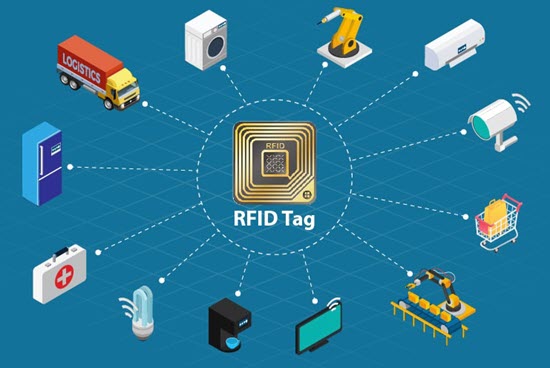What are RFID Tags? How do RFID Tags Work?


RFID (Radio Frequency Identification) tags are rapidly becoming part of our daily lives, yet many people are still unfamiliar with this technology.
RFID tags are embedded in various items to automate inventory management, enhance supply chain visibility, and support numerous applications across different industries. RFID technology in important in streamlining operations, improving accuracy, and facilitating data collection without direct contact or line of sight.
In this article, we will take a closer look at what RFID tags are, how they work, the advantages and disadvantages of RFID technology and some of the ways in which they are being used today.
RFID tags are a type of tracking system that uses smart barcodes in order to identify items. RFID is short for “radio frequency identification,” and as such, RFID tags utilize radio frequency technology.
These radio waves transmit data from the tag to a reader, which then transmits the information to an RFID computer program. RFID tags are frequently used for merchandise, but they can also be used to track vehicles, pets, and even patients with Alzheimer’s disease.
An RFID tag may also be called an RFID chip.
An RFID tag works by transmitting and receiving information via an antenna and a microchip — also sometimes called an integrated circuit or IC. The microchip on an RFID reader is written with whatever information the user wants.

There are two main types of RFID tags: battery-operated and passive.
Passive RFID tags use three main frequencies to transmit information:
The frequency used to transmit information affects the tag’s range.
When a passive RFID tag is scanned by a reader, the reader transmits energy to the tag which powers it enough for the chip and antenna to relay information back to the reader. The reader then transmits this information back to an RFID computer program for interpretation.
There are two main types of passive RFID tags: inlays and hard tags.
Active RFID tags use one of two main frequencies — either 433 MHz or 915 MHz — to transmit information. They contain three main parts, including:
The battery in an active RFID tag should supply enough power to last for 3-5 years. When it dies, the entire unit will need replaced, as the batteries are not currently replaceable.
There are two main kinds of active RFID tags: beacons and transponders.

RFID tags used in a wide range of applications, including:
Overall, RFID technology enables automated data collection and can improve efficiency, accuracy, and security in a variety of industries and applications.
Since an active RFID is constantly sending out a signal, it makes an excellent choice for those looking for up-to-the-minute live tracking, such as in tolling and real-time vehicle tracking applications. They are an expensive product, but they do offer a long read range, which may be preferred depending on their application.
Passive RFID tags are a much more economical choice than active RFID tags, and cost around 20 cents each. This makes them a popular choice for supply chain management, race tracking, file management, and access control applications.
While a passive RFID tag does not require a direct line of sight to the RFID reader, it has a much shorter read range than an active RFID tag. They are small in size, lightweight, and can potentially last a lifetime.
Since active RFID tags feature a larger, more rugged design than passive RFID tags, they are better suited for applications where durability is required. They are frequently used in toll payment transponder systems, cargo tracking applications, and even in devices used to track people.
What are some of the main advantages of using RFID tags:
Overall, the use of RFID tags can provide numerous benefits for businesses and organizations looking to improve their supply chain management and inventory tracking processes.
RFID tags aren’t ideal compared to other tracking labels for a number of reasons. Some major problems with RFID include different security and technological issues.
Security Issues
When it comes to security, RFID tags cannot distinguish between readers, which means the information can be read by almost anyone once it has left the original supply chain. Because RFID readers are so portable, and the range of some tags so great, scammers can gather information they would otherwise not have access to. This means that anyone can collect potentially sensitive information without a person’s knowledge.
Another security concern for consumers is that RFID tags can be linked to individual credit cards, creating the potential for financial theft and fraud.
Technology-wise, RFID tags are problematic largely because there are no real global or industry standards. Since they operate on radio frequency, RFID tags and their systems can also easily become jammed or disrupted, reducing their usability. This results in longer wait times and decreased productivity in both retail and warehouse settings.
Technology Issues
There are also signal issues that can occur with RFID inventory systems, including collision — when signals from two or more readers overlap, and interference caused by metal, water, or other magnetic fields in the surrounding area.
Set Up Issues
An RFID system is also time-consuming and labor-intensive to set up. Companies need to test various hardware and tag systems to determine the best fit, which can take months to arrange. In addition to the cost of the RFID system itself, such as RFID tags and scanners, an increase in time and labor also means an increase in cost.
These types of disadvantages are often avoided with the use of barcodes, which is why they are still a popular data collection and inventory control choice for many businesses.
RFID tags are used for a variety of applications, including inventory management, tool tracking, asset tracking, equipment tracking, and more. Generally, they’re used to monitor an asset’s location or condition as it moves throughout an organization or the supply chain.
Yes, RFID tags can be tracked. Active RFID tags can be tracked automatically, and passive RFID tags can be tracked manually.
Yes, RFID tags can be hacked. They can be sensitive to radio interference, which can disrupt performance and readability.
Some RFID tags are rewriteable, and hackers can delete or replace the data. Sensitive data can also be intercepted by hackers if the data isn’t encrypted during transmission.
Yes, RFID tags can track location, but to what extent depends on the type of RFID tag. Active RFID tags are battery-powered and can be detected within 300 feet of an RFID reader.
With some active tags, triangulation enables location tracking with +/- 10 foot accuracy. Passive tags, which rely on the radio signal transmitted by the RFID reader, which typically must be within about three to 16 feet of the RFID tags.
Due to their limited scanning range, passive RFID tags are often used in applications such as inventory management within a warehouse or facility, as RFID readers can be placed in strategic locations for inventory monitoring.
Other use cases include access control, livestock tracking, ticketing, payment, and data transfer applications, and distribution and logistics operations, among others.
Radio Frequency Identification (RFID) tags are an ideal asset tracking system in certain applications. However, RFID does have some inherent shortcoRadio Frequency Identification (RFID) tags are an ideal asset tracking system in certain applications. However, RFID does have some inherent shortcomings in functionality, durability and security. Click below to see the pros and cons of RFID, as well some alternatives that may be better suited to your particular tracking project.mings in functionality, durability and security. Click below to see the pros and cons of RFID, as well some alternatives that may be better suited to your particular tracking project.
Our sales engineers are experts in automatic asset tracking, tagging and identification,a nd can answer all your questions. Get in touch now.
Lets Talk ›Enter your information and get a free checklist of the top questions to answer and tips to plan a successful asset tagging project for any asset management or tracking system implementation.